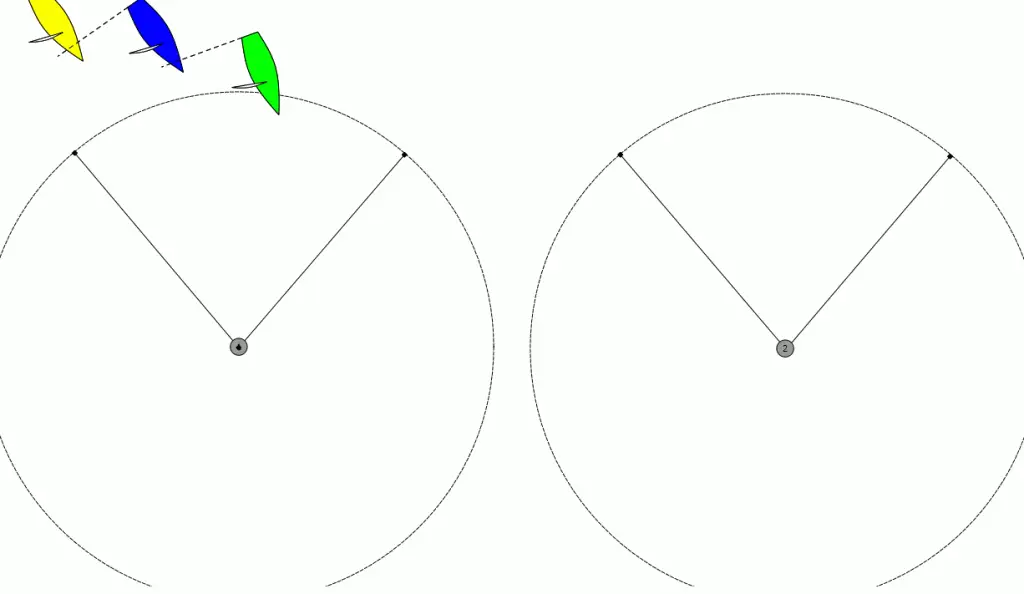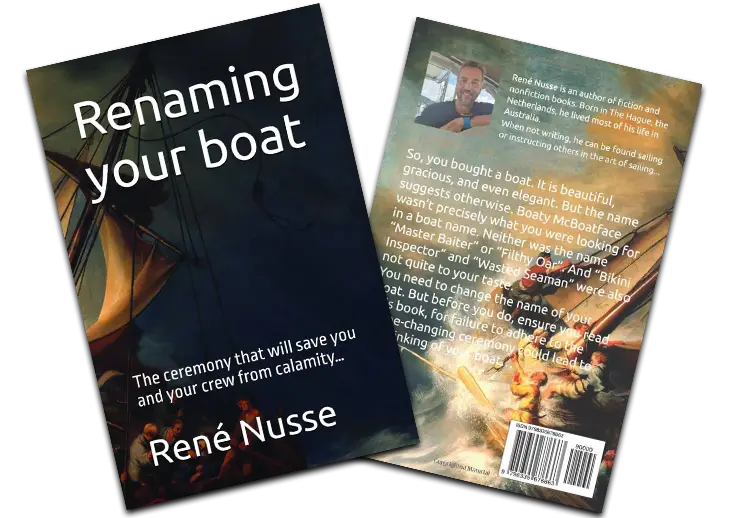Rule 18.2 is all about giving mark-room. The rule is in place because traffic around a mark can be hectic. Rule 18.2 gives specific rights and obligations to certain boats so we can round marks in a more orderly and safe manner.
In the previous post, we discussed Rule 18.1 which was in essence about when Rule 18 applies and when it does not. Knowing this, we can get stuck into the operation of Rule 18.2 – Giving Mark Room.
Let’s start with what Rule 18.2 says…
18.2 Giving Mark-Room
(a) When the first of two boats reaches the zone,
(1) if the boats are overlapped, the outside boat at that moment shall give the inside boat mark-room;
2) if the boats are not overlapped, the boat that has not reached the zone at that moment shall give the other boat mark-room.
When a boat is required to give mark-room by this rule, she shall continue to do so for as long as this rule applies, even if later an overlap is broken or a new overlap begins.
(b) Rule 18.2(a) no longer applies if the boat entitled to markroom passes head to wind or leaves the zone.
(c) When rule 18.2(a) does not apply and the boats are overlapped, the outside boat shall give the inside boat mark-room.
(d) If a boat obtained an inside overlap from clear astern or by tacking to windward of the other boat and, from the time the overlap began, the outside boat has been unable to give mark-room, rules 18.2(a) and 18.2(c) do not apply between them.
(e) If there is reasonable doubt that a boat obtained or broke an overlap in time, it shall be presumed that she did not.
Before getting into detail about Rule 18.2 and providing mark-room, let’s remind ourselves what we mean by “mark-room” and “room” which are both defined terms.
Let’s run with example 1 below using Rule 18.2(a) which is by far the most common application of Rule 18. Because yellow and blue are overlapped and on the same tack, the windward boat needs to stay clear of the leeward boat under Rule 11.
However, irrespective of the overlap we now know that Rule 18 applies because one boat is in the zone and none of the exemptions apply.
We can see that when the first boat reaches the zone, there is an overlap, so let’s look again at the first part of Rule 18.2(a).
if the boats are overlapped, the outside boat at that moment shall give the inside boat mark-room;
We can therefore say that Rule 18.2(a) mandates blue to give mark-room to yellow as illustrated in a very familiar scenario below.

So below in example 2, we see yellow trying to take advantage of Rule 18.2(b) by pushing blue to port and away from the mark. Again, it is worth remembering that Rule 18 is merely an overlay and supplement the rules in Part A and Part B including:
- Rule 10 – port and starboard tack
- Rule 11 – windward and leeward
- Rule 12 – clear ahead or clear astern
- Rule 13 – tacking
- Rule 15 – acquiring right of way
- Rule 16 – changing course
- Rule 17 – proper course
All these rules still apply so in example 2 below, yellow is bound by Rule 11 to stay clear of blue because they are on the same tack and yellow is the windward boat. Because yellow is not in her “lane”, she loses her rights under Rule 43 and will not be exonerated for breaking Rule 11.

So hopefully, this puts some background and context to Rule 18.2 and how it applies. Let’s dig a little deeper and look at some scenarios…
Scenario 1
Let’s reiterate the most common scenario in real life which is covered by Rule 18.2(b). At position 2, blue has reached the zone and yellow is no longer clear astern and overlapped. Both boats are on the same tack and need to round the mark leaving it on their starboard side.

YES, blue is required to give mark-room to yellow
Scenario 2
Let’s look at a small variation. At position 1, blue has reached the zone but is clear ahead of yellow. At position 2, yellow realises that blue is closing the gap for yellow to sail into on her way to round the mark and therefore hails “MARK -ROOM!”. Blue hails back immediately with “NO ROOM!” as she continues to close the gap. When it is clear to yellow that no mark-room is provided she protests and goes into a forced gybe after which she continues to round the mark.

NO, blue is not required to give mark-room to yellow
Because yellow is clear astern, she needs to give blue mark-room if that scenario would eventuate.
Scenario 3
In the below scenario at position 1, there is no overlap when yellow reaches the zone. Then at position 2, red establishes an overlap and promptly hails “OVERLAP – ROOM AT THE MARK!”. When yellow hails back “NO ROOM” at position 3 and gybes to round the mark, red takes action to avoid a collision and protest yellow.

NO, yellow is not required to give mark-room to red
Rule 18.2 applies but there was no overlap when yellow reached the zone so she does not have to give red mark-room. Red's protest is denied.
If fact, red need to give yellow mark-room if the need arises under Rule 18.2(c)(2)...

Scenario 5
Yellow, blue, and green approach a gate mark. Blue has some issues with her sails and gets out of the way tucking in behind green without contact.
The battle is now on between green and yellow. Yellow is hailing for room but green doesn’t reply. At position 4, green touches yellows stern without resulting in damage or injury.
Yellow protests Green for failing to give mark-room. Green protested yellow on the basis that there was no overlap between yellow and green and therefore yellow needed to give mark-room to green.

YES, green is required to give mark-room to yellow
Yellow's protest will be upheld.
So to sum up Rule 18.2…
- The logical question in determining if we need to give mark-room is this. “Was the leading boat at the moment she entered the zone clear ahead? If so, she doesn’t have to give mark-room.”
- If we determine through Rule 18.1 that Rule 18 applies then it is safe to say that we can get clarification from Rule 18.2(a) OR Rule 18.2(b), the latter being far more common.
- Applies to windward and leeward marks.
- If you allege that there was or was not an overlap you require evidence because if there is any reasonable doubt, your assertion will be denied.
- Rule 18 ends as soon as mark-room is given.
Author
-

Rene is a keelboat instructor and sailing coach in the Mandurah area WA. He is also the author of several books about sailing including "The Book of Maritime Idioms" and "Renaming your boat".
View all posts


